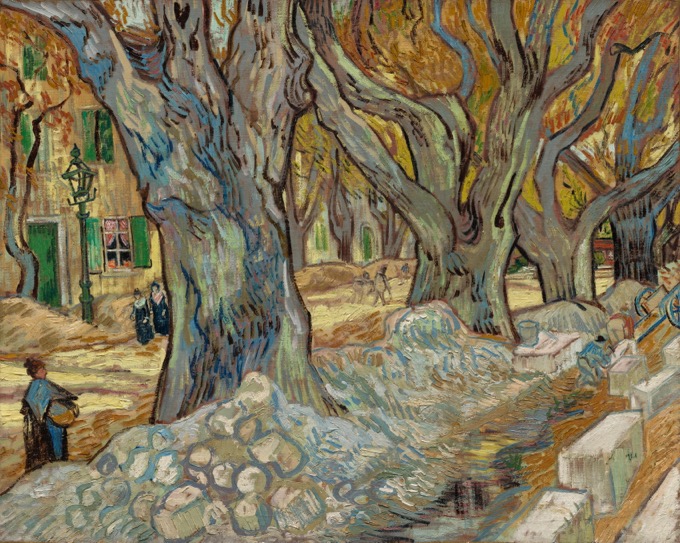TopCoating

Vincent van Gogh: The Large Plane Trees
[Road Menders at Saint-Rémy] (1889)
"TopCoating's practice for the FinishCoat's flourish."
©2022 by David A. Schmaltz - all rights reserved
I believe our language proves generally inadequate to represent our experience. We adopt labels which, if taken literally, seem to materially misrepresent what they intend to impart, but we've mostly tacitly agreed to let that insufficiency pass, considering no better could possibly be following. To become educated, then, might be to finally be introduced to the real meanings, those which cannot take formal form in words or phrasings. I might say I've been painting without noting or even really intending to suggest that I've said almost nothing about what I've actually been doing, for painting, like everything else, comes in layers, in stages, and it depends upon which stage I've been engaging in, whether I've managed to impart any understanding about what I have actually been doing. I could give a hint, though, that the part of painting I have been engaging in actually involved a brush and paint. This almost makes this stage unique in the various stages of painting. Not all painting involves paint or brushes.
I was engaging in the fine and satisfying art of TopCoating yesterday, this effort distinct from the equally fine and perhaps even more satisfying art of FinishCoating, which I expect to engage in later this morning. TopCoating covers the primer, which I applied like a five year old might, sloppy and with purposeful carelessness. The prime coat just needs to thoroughly cover, with no points awarded for style, especially the primer I'm using, so-called peel bonding primer, which seals the surface beneath an impenetrable waxy plastic coating which stays pliable regardless of temperature, this to ensure that whatever might otherwise bleed out from underneath, doesn't. Once that prime coat's dry, my canvas is ready. TopCoating's all about making the first pass at covering the underneath.
Try though I might, TopCoating won't be the last pass over this surface. It will need a finish to fill in invisible gaps between the past and the future. After the TopCoat dries, I might not be able to spy a single instance where the prime coat's bleeding through, yet a finish coat will still be required. That final, second top coat pass, makes a real difference, leaving more depth on the surface than a single pass could allot. TopCoating might try to cover, but knowing that it actually doesn't matter if a few spots shine through feels freeing. The FinalCoat will cover whatever sins I might commit when TopCoating, so TopCoating's relaxing, almost a reward. After the inevitable struggle of prepping with its messing caulking and awkward sanding, TopCoating's a breeze. I brush the joins and ends, then roll the siding board, then smooth with the brush before moving on. A few seconds and a perfect albeit preliminary finish gets left behind.
My attention wains. Unlike the preparation work, I needn't maintain a particularly watchful eye when I'm TopCoating. My greatest concern comes from the hypnotic state that TopCoating induces in me. I'm very likely to develop some repetitive motion complaint after an hour or two of almost perfect repetition. My hands become claw-like after time spent grasping that brush. I could become inattentive enough to do myself some serious damage, so I need to carry a certain awareness, one seemingly sealed beneath some kind of peel bond primer of its own. That wall becomes my canvas and I become an accomplished painter, creating for the ages, though the final surface will cover this preliminary one. TopCoating's practice for the FinishCoat's flourish.


